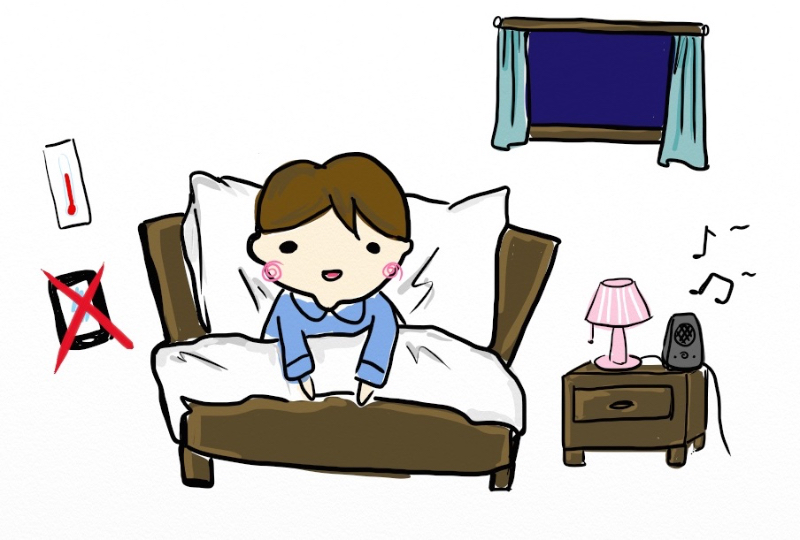Sleep Hygiene
◅ Sleep tipsSleep hygiene is all about developing a certain mind set, space and routine to prepare yourself to go to sleep. It has been shown that sleep hygiene can lead to a better sleeping experience.

Here are some tips for better sleep hygiene!
1. Make child's bedroom 'sleep friendly'!
Things such as bright sunlight, extreme temperature (too hot/ too cold) and disturbing noise can get in the way of sleep. Make the bedroom a dark, quiet and comfortable one for your child.
2. Bedtime routine
Set aside 30-90 minutes before bedtime for your child to 'wind down'. This helps them relax their minds and bodies in preparation for sleep. You can do this by, for example, listening to relaxing soft music with them.
3. Strengthen the association between bed and sleep
In a normal situation, the pairing of bed and sleep alone elicits sleep onset. However, when a child stays in bed for a very long time trying to rest or carry out non-sleeping activities, the bed and the bedroom are no longer only associated with sleep, but more frequently paired with non-sleeping behaviours (e.g. using phone). Therefore, encourage your child to go to bed only when he/she feels sleepy. Decrease the duration of his/her non-sleeping activities in bed and do these elsewhere.
4. When the child cannot fall asleep… try 'the 15-minute rule'.
When your child is unable to fall asleep within 15 minutes, encourage him/her to get up and go to a different room, and return to the bedroom only when he/she feels sleepy again. This is in the hopes to strengthen the association between the bed, bedroom and sleep.
5. Regular rise time
Setting regular wake up times throughout the week can help your child build up 'sleep pressure' which helps him or her get better sleep that night.
6. Staying active in the day
Having your child engage in regular physical activities can give him/her a better night's sleep. However, any strenuous exercise should be done at least 2 hours before bedtime, or it could cause negative results!
7. Avoid heavy meals just before bedtime
Help your child maintain regular meal times. Also research has found that the digestive process can affect sleep. Avoid having heavy meals or sugary food within four hours before bedtime.
8. Make good use of natural light
When your child gets up in the morning, expose him/her to natural sunlight to wake him/her up. This can be done by opening up their curtains when it is time to wake up. Before bedtime, have your child be around low-lit areas in order to increase melatonin, a hormone promoting sleep.
9. Avoid the use of electrical devices in bed
Electrical Devices such as phones and tablets, and the TV give out a large amount of blue light, which is harmful as it suppresses the sleep hormone, melatonin. Thus, avoid letting your child play on such devices before bedtime.
10. Be smart about napping
Most children give up their naps at 4-4.5 years. If a child really needs an afternoon nap, it is recommended to arrange the nap between 12-1 p.m. in the afternoon. It is advised not to let your child nap after 4 p.m. A reasonable nap duration is 5-15 minutes, and 30 minutes is the recommended maximum. The longer your child is awake during the day, the more 'sleep pressure' builds up, which ensures a faster and sounder sleep. Therefore, long naps will affect the child's sleep at night. Therefore, as your child grows up, parents should help incorporate his/her nap into night time sleep.

References:
- Cohen, S., Conduit, R., Lockley, S. W., Rajaratnam, S. M., & Cornish, K. M. (2014). The relationship between sleep and behavior in autism spectrum disorder (ASD): a review. Journal of Neurodevelopmental Disorders, 6(1).
- Devnani, P. A., & Hegde, A. U. (2015). Autism and sleep disorders. Journal of Pediatric Neurosciences, 10(4), 304–307.
- Johnson, C. R., Handen, B. L., Mayer-Costa, M., & Sacco, K. (2008). Eating Habits and Dietary Status in Young Children with Autism. Journal of Developmental and Physical Disabilities, 20(5), 437–448.
- Liu, X., Hubbard, J. A., Fabes, R. A., & Adam, J. B. (2006). Sleep Disturbances and Correlates of Children with Autism Spectrum Disorders. Child Psychiatry and Human Development, 37(2), 179–191.
- Mazurek, M. O., Engelhardt, C. R., Hilgard, J., & Sohl, K. (2016). Bedtime Electronic Media Use and Sleep in Children with Autism Spectrum Disorder. Journal of Developmental and Behavioral Pediatrics: JDBP, 37(7), 525–531.
- Reynolds, A. M., & Malow, B. A. (2011). Sleep and autism spectrum disorders. Pediatric Clinics of North America, 58(3), 685–698.
- Wachob, D., & Lorenzi, D. G. (2015). Brief Report: Influence of Physical Activity on Sleep Quality in Children with Autism. Journal of Autism and Developmental Disorders, 45(8), 2641–2646.
- Wang, G., Liu, Z., Xu, G., Jiang, F., Lu, N., Baylor, A., & Owens, J. (2016). Sleep Disturbances and Associated Factors in Chinese Children with Autism Spectrum Disorder: A Retrospective and Cross-Sectional Study. Child Psychiatry and Human Development, 47(2), 248–258.
